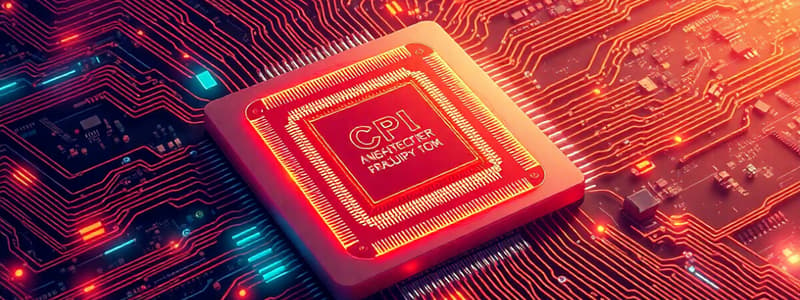Podcast
Questions and Answers
What are the main aims of the processor?
What are the main aims of the processor?
Fetching an instruction from memory, executing the instruction, identifying the next instruction.
Which component of the processor performs arithmetic and logical execution?
Which component of the processor performs arithmetic and logical execution?
- Arithmetic and Logical Unit (ALU) (correct)
- Bus
- Control Unit (CU)
- Registers
The Control Unit (CU) has internal storage.
The Control Unit (CU) has internal storage.
False (B)
What is the purpose of registers?
What is the purpose of registers?
Which of the following is NOT an advantage of using registers?
Which of the following is NOT an advantage of using registers?
What does the Instruction Register (IR) hold?
What does the Instruction Register (IR) hold?
What is the role of the Program Counter (PC)?
What is the role of the Program Counter (PC)?
What does the Memory Address Register (MAR) do?
What does the Memory Address Register (MAR) do?
What is the function of the Status Register (SR)?
What is the function of the Status Register (SR)?
Describe the fetch and execute cycle.
Describe the fetch and execute cycle.
The fetch phase ends after the instruction is decoded.
The fetch phase ends after the instruction is decoded.
Flashcards are hidden until you start studying
Study Notes
Central Processing Unit (CPU)
- The main functions of the CPU involve fetching instructions from memory, executing them, and determining subsequent instructions.
Processor Components
- Arithmetic and Logical Unit (ALU): Executes arithmetic and logical operations; does not have internal storage.
- Control Unit (CU): Directs and coordinates the sequence of operations, interprets instructions, and sends signals to the ALU and registers.
- Registers: High-speed storage areas within the CPU for temporary data storage during instruction execution; types include data or instructions.
Advantages of Registers
- Reduced instruction length: Registers require fewer bits for referencing compared to memory addresses.
- Shorter execution time: Using registers for complex calculations minimizes clock cycles.
- Simplified programming: Incrementing addresses in registers speeds up data retrieval from consecutive memory blocks.
Types of Registers
- Instruction Register (IR): Holds the currently executing instruction and provides output to the CU for timing signals.
- Program Counter (PC): Contains the address of the next instruction. Updates to point to the following instruction during execution.
- Stack Pointer (SP): Points to the memory address of the stack for temporary data or address storage.
- Memory Address Register (MAR): Holds the memory address for data transfer operations.
- Memory Data Register (MDR): Contains data to be written to or read from the specified memory location.
- Status Register (SR)/Conditional Code Register (CCR)/Status Flags: Contains bits to indicate processor conditions resulting from arithmetic/logical operations including flags for carry, positive result, zero result, negative result, and overflow.
Program Execution: Fetch and Execute Cycle
-
Programs are loaded into consecutive memory locations via the input unit, initialized by setting the PC to the first instruction.
-
The CPU executes programs through a repetitive fetch/execute process, which includes:
- PC holds the address of the current instruction.
- Instruction is fetched from memory into the IR.
- PC updates to the address of the next instruction.
- The CU decodes the instruction, marking the end of the fetch phase.
Detailed Fetch and Execute Steps
- Identify and fetch any necessary data from memory into registers.
- Repeat data fetching if required by the instruction.
- Execute the instruction as per operational requirements.
- Store results as specified before fetching the next instruction.
- Cycle through these steps continuously until program completion.
Studying That Suits You
Use AI to generate personalized quizzes and flashcards to suit your learning preferences.




